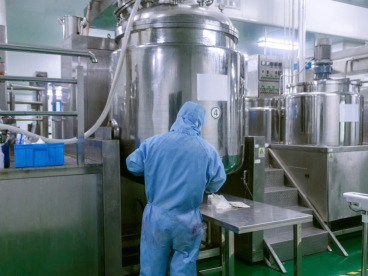Chemical Plant Workers and Asbestos
Chemical engineers and chemical plant workers produce products such as chemicals, resin, filaments, cleaning compounds and pharmaceuticals. Workers wore asbestos protective gear in the past, and can still be exposed to asbestos when working on older equipment and in plants with asbestos building materials.

Written by Michelle Whitmer • Edited By Walter Pacheco • Scientifically Reviewed By Arti Shukla, Ph.D.
Asbestos.com is the nation’s most trusted mesothelioma resource
The Mesothelioma Center at Asbestos.com has provided patients and their loved ones the most updated and reliable information on mesothelioma and asbestos exposure since 2006.
Our team of Patient Advocates includes a medical doctor, a registered nurse, health services administrators, veterans, VA-accredited Claims Agents, an oncology patient navigator and hospice care expert. Their combined expertise means we help any mesothelioma patient or loved one through every step of their cancer journey.
More than 30 contributors, including mesothelioma doctors, survivors, health care professionals and other experts, have peer-reviewed our website and written unique research-driven articles to ensure you get the highest-quality medical and health information.
About The Mesothelioma Center at Asbestos.com
- Assisting mesothelioma patients and their loved ones since 2006.
- Helps more than 50% of mesothelioma patients diagnosed annually in the U.S.
- A+ rating from the Better Business Bureau.
- 5-star reviewed mesothelioma and support organization.
Testimonials
My family has only the highest compliment for the assistance and support that we received from The Mesothelioma Center. This is a staff of compassionate and knowledgeable individuals who respect what your family is experiencing and who go the extra mile to make an unfortunate diagnosis less stressful. Information and assistance were provided by The Mesothelioma Center at no cost to our family.LashawnMesothelioma patient’s daughter
How to Cite Asbestos.com’s Article
APA
Whitmer, M. (2024, March 25). Chemical Plant Workers and Asbestos. Asbestos.com. Retrieved April 18, 2024, from https://www.asbestos.com/occupations/chemical-plant-workers/
MLA
Whitmer, Michelle. "Chemical Plant Workers and Asbestos." Asbestos.com, 25 Mar 2024, https://www.asbestos.com/occupations/chemical-plant-workers/.
Chicago
Whitmer, Michelle. "Chemical Plant Workers and Asbestos." Asbestos.com. Last modified March 25, 2024. https://www.asbestos.com/occupations/chemical-plant-workers/.
How Chemical Plant Workers Are Exposed to Asbestos
A chemical plant is an industrial processing facility where chemicals are blended and manufactured on a large scale. This work involves high temperatures to produce certain chemicals. Asbestos is resistant to heat and chemical corrosion, which is why it was used in chemical plants.
Chemical engineers, technicians and other workers are responsible for producing a wide range of products, including basic chemicals, pharmaceuticals, soap, cleaning compounds, resins, synthetic rubber and artificial synthetic fibers and filaments. Producing these products requires working with heat and chemicals that could harm workers if they are not wearing personal protective equipment.
Unfortunately, asbestos was used in the safety gear worn by chemical plant workers. It was woven into gloves, aprons and fire blankets. Asbestos was also used to make laboratory countertops that were resistant to heat and chemical reactions, and was found in lab ovens as a liner and form of insulation. Those who currently work in these plants are at a much lower risk of asbestos exposure, but asbestos-containing material may still be found in buildings, machinery and equipment that were made prior to the 1980s.
Chemical Process Engineers, Operators and Asbestos
Chemical process engineers, plant process supervisors and chemical plant operators are responsible for overseeing operations at the plant to promote production and safety. They oversaw chemical product production, which involved inspecting equipment and processes at the plant.
Equipment that operated at high temperatures was likely to contain asbestos. Different types of asbestos were used for various purposes in the production of nitric acid at certain chemical plants. Large asbestos packing, mainly crocidolite asbestos, but also other types of asbestos, were used to pack the joints in the incinerators used to produce nitric acid. Installing and removing this packing could lead to asbestos exposure.
Process engineers and plant operators were responsible for ensuring equipment was in working order even if they didn’t repair the equipment themselves. Simply being near the equipment and working in the same facility could result in asbestos exposure. Certain chemical plants made asbestos-containing products that required process engineers, chemical technicians and operators to handle raw asbestos fibers.
Chemical Plant Machine Maintenance and Asbestos
Chemical equipment operators, tenders, grinding machine operators and drill press operators handle equipment that controls chemical changes or reactions in the processing of industrial or consumer products. Some of the equipment used at different plants may have contained asbestos insulation, asbestos gaskets or seals.
When workers operated and repaired this equipment, they could have released asbestos fibers. Replacing and repairing asbestos-containing parts could lead to exposure among anyone working near the equipment.
Chemical Facilities Maintenance and Asbestos
Chemical plant maintenance workers, warehouse workers and assembly workers may have been exposed to asbestos building materials in the plant. These asbestos-containing materials included insulation, heat-resistant panels, plumbing pipes, steam pipes, flooring tiles, ceiling tiles, HVAC equipment and electrical wiring.
When workers installed, repaired or replaced these materials, the risk of asbestos exposure was high. This work had the potential to release asbestos fibers throughout the plant.

Asbestos Products Associated with Chemical Plant Technicians
Asbestos was used throughout chemical plants because of its natural resistance to heat and chemical corrosion. Sometimes workers were exposed to asbestos when they conducted small repairs instead of paying a repairman, such as sealing pipes with asbestos powder. Workers could have also been exposed if they simply brushed against an insulated pipe or other insulated equipment and disturbed asbestos, releasing fibers that could be inhaled. Asbestos gaskets were used to prevent leakage between solid surfaces in plants. During routine gasket removal, workers and mechanics were exposed to asbestos fibers.
Prior to and during the late 1970s, asbestos was used in chemicals and plastics as a filler or reinforcing agent. Asbestos fibers were commonly added to molding compounds and fireproofing sprays. Asbestos compounds were also in chemicals used for insulation and sealants. Phenolic compounds that were produced and distributed to plastic manufacturers also commonly contained asbestos.
Chemical plant workers may have been exposed to the following asbestos products:
- Raw Asbestos: Certain chemical plants produced asbestos-containing products such as plastic molding compounds. This required workers to handle bags of raw asbestos fibers.
- Protective Gear: Chemical plant workers wore asbestos-containing protective clothing, including face masks, gloves, coveralls and aprons, to protect themselves from heat and harsh chemicals. They also used asbestos blankets to put out any fires that developed during combustion of chemicals.
- Equipment: Incinerators, lab ovens, lab countertops, mixing machines, steam-jacketed kettles and reactor vessels may have been insulated with asbestos materials, including packing, heat panels, and stove and furnace cement. Asbestos was a vital insulation component in chemical plant machinery and equipment, and it could be found in pipes, pumps, valves, furnaces, boilers, driers, radiator stop-leak products, Bunsen burner pads, gaskets and grinders.
- Facilities: Asbestos-containing building materials were used to construct chemical plants through the 1980s. Some of these asbestos materials included insulation, pipes, flooring, ceiling tiles, wallboard, HVAC duct connectors, electrical wiring, paint films, sealants, molding compounds, benches and countertops, adhesives, molded flexible parts, and cement block primers and elastomers, which are used as seals.
Manufacturers Who Made Products Chemical Plant Workers Use
The following manufacturers who exposed chemical plant workers to asbestos are some of the biggest names in American business, including Chevron, DuPont, Monsanto and Westinghouse Electric.
Manufacturers who made asbestos products that exposed chemical plant workers include:
- Chevron Phillips Chemical Co.: This company made asbestos-containing drilling fuel also known as drilling mud.
- Dow Chemical Co.: Dow used asbestos products throughout its chemical plants and issued asbestos-containing safety gear to employees.
- DuPont: DuPont used different types of asbestos products in its chemical plants through the 1980s.
- Durez Corporation: Durez manufactured plastic molding compound with asbestos in its chemical plants.
- General Electric: GE made asbestos-containing phenolic molding material, wires, arc chutes and furnaces used in chemical plants.
- Hill Brothers Chemical: Hill Brothers operated a chemical plant that made asbestos-containing cementitious magnesite that was used to manufacture flooring.
- Hooker Chemical: This company operated a chemical plant in Niagara Falls, New York, where some former workers have developed asbestos-related diseases.
- Monsanto Company: Monsanto was a chemical company before it became an agricultural company. It employed chemical plant workers that have developed asbestos-related diseases.
- Rogers Corporation: Rogers sold asbestos-containing phenolic plastic molding compounds to chemical plants.
- Rostone Inc.: This company sold asbestos-containing phenolic plastic compounds and molded asbestos-containing parts to chemical plants.
- Westinghouse Electric: Westinghouse made cables, gaskets, packing and panels containing asbestos that were used in chemical plants.
Mesothelioma and Chemical Plant Workers
Scientific studies have reported on the association between asbestos exposure and the development of mesothelioma in chemical plant workers. According to a 2022 report by the European Commission, over 70,000 workers died in 2019 from past exposure to asbestos.
- In 2015, a British Medical Journal study reported asbestos-related deaths in Belgian workers from 2001 to 2009. According to the data, chemical plant workers are almost three times more likely to die of mesothelioma than the general population.
- In 2005, the journal Occupational Medicine published results of a 35-year study conducted from 1953 to 1988 of workers of a Norwegian electrochemical plant that produced nitric acid. The study found that workers who packed the joints in incinerators were exposed to high concentrations of asbestos dust. Maintenance work on the plant’s 79 incinerators was continuous and workers were exposed to asbestos in the incinerators daily. Considerable amounts of asbestos dust were generated in the warm dry atmosphere of the incinerator hull when old, dry packing material was replaced.
- In a study conducted in the 1970s, several large groups of chemical plant workers had chest X-rays taken, and abnormalities associated with asbestos, such as small irregular opacities and pleural changes, were found in a portion of those examined. A cross-sectional study of 185 maintenance workers in a large chemical plant found that nearly 60% of those examined showed symptoms of asbestosis and precancerous conditions.
Mesothelioma is a type of cancer that is primarily caused by asbestos exposure. Asbestos exposure also causes lung cancer, ovarian cancer, laryngeal cancer and a progressive lung disease called asbestosis. Occupational asbestos exposure in chemical plants has caused many workers to develop these diseases.
The nation’s top mesothelioma specialists work at some of the best cancer centers in the country. It’s important to find a doctor specializing in your diagnosis to access innovative treatments and get the best chance of living longer with asbestos-related diseases.

Compensation for Chemical Plant Workers Exposed to Asbestos
Chemical plant workers have successfully sued some of the biggest names in the chemical industry, including Dow Chemical, for asbestos exposure.
- In August 2013, a Louisiana jury ordered Dow Chemical to pay $5.95 million to Sidney Mabile, who sued the company claiming working at its chemical plant in Plaquemine, Louisiana, exposed him to asbestos and caused him to develop mesothelioma. Court documents revealed that Dow lobbied to oppose the U.S. Environmental Protection Agency’s proposed ban on asbestos in the late 1980s. The plaintiff’s lawyers argued that Dow was continuing to use asbestos in its plants long after other chemical companies had stopped because it was 10% cheaper than alternatives.
- In May 2011, former chemical plant worker Thomas Brown was part of arguably the most controversial asbestos-related lawsuit in U.S. history. Brown won the biggest jury award from his lawsuit – $322 million from Chevron Phillips Chemical Co. and Union Carbide Corporation – after claiming he was exposed to asbestos while on the job. He sued after he was diagnosed with asbestosis. His failing health required him to use oxygen 24 hours a day. The jury awarded Brown $300 million in punitive damages and $22 million in actual damages. Mississippi Circuit Judge Eddie Bowen threw out the landmark verdict, ruling the original judge should have disclosed that his parents previously were involved in an asbestos-related lawsuit against one of the defending companies. The case was retried and the court ruled in favor of Union Carbide. No information was provided about Chevron Phillips, which may have settled with the plaintiff.
- On March 17, 2011, a Texas family won a lawsuit against Dow Chemical and Alcoa Aluminum claiming Robert Henderson died of mesothelioma cancer because of asbestos exposure he endured while working at Dow for 10 months in 1967 and for 29 years at an Alcoa Aluminum plant in Pittsburgh. Attorneys representing the family claimed Henderson’s death was caused by his daily exposure to Dow’s asbestos-containing insulation. The Henderson family was awarded $9 million. Dow Chemical was responsible for 30% of the awarded amount and Alcoa Aluminum was responsible for the remaining 70%.
Former chemical plant workers who develop asbestos-related diseases have the right to file personal injury lawsuits and asbestos trust fund claims to seek compensation. Family members who lose a loved one to mesothelioma have the right to file a wrongful death lawsuit to seek compensation for medical expenses, lost wages and funeral costs.
It is important to find an experienced mesothelioma attorney to guide you through the legal process. They can advise whether you qualify to file multiple legal claims, including lawsuit and trust fund claims.







